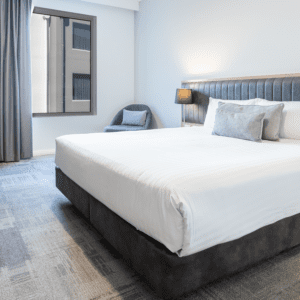
Surging inbound tourism will help boost Australia’s hotel occupancy levels this year and next while spurring room rate growth in most markets, particularly Sydney and Brisbane, according to new CBRE forecasts.
CBRE’s latest Hotels Australia Overview and Outlook report highlights that domestic travel in commercial accommodation across Australia surpassed pre-pandemic levels in 2023 in terms of both travel nights and spending across most states, despite an uplift in outbound international travel.
In the global gateway states of New South Wales and Victoria, domestic travel nights were up 5% and 13% respectively on the year prior
CBRE’s Australian Head of Hotels Research Ally McDade said she anticipated a consolidation in the domestic tourism market throughout 2024 as last year’s outbound travel spike – which was driven by pent-up demand – began to moderate.
“The high cost of overseas flights and accommodation combined with geopolitical tensions globally are expected to benefit the local sector. However, continued pressure on consumer sentiment due to interest rates and cost of living concerns are likely to present ongoing challenges,” Ms McDade said.
The report shows that international visitation to Australia continues to recover, with some markets such as Nepal, Vietnam, Fiji, Ireland, and South Korea surpassing 2019 arrival numbers. However, there is still a gap to bridge, with short-term overseas arrivals 24% below pre-pandemic levels in 2023.
Overall Australian outbound travel on a short-term basis recovered to 88% of 2019 volumes in 2023, with closer regional destinations likely to benefit from continued growth.
CBRE Regional Director, Hotel Valuations, Troy Craig noted, “Performance indicators experienced solid growth in 2023 with Average Daily Rate (ADR), Occupancy and Revenue Per Available Room RevPAR increasing 4%, 7% and 11%, respectively, although the rate of growth has moderated compared to the rapid pace achieved in 2022.”
On the supply front, the report highlights that the new supply pipeline is likely to contract due to increased borrowing and construction costs. Most new stock will be at the premium end, with limited mid-range and economy projects.
Melbourne has the most hotel rooms coming online; however, occupancy levels have been strong in the face of new supply which is expected to remain the case given the city’s diverse range of demand generators.
From an investment perspective, despite the headwinds of heightened debt costs and inflationary pressures, transaction volumes were very strong in 2023 at almost $2.4 billion – the second highest ever recorded.
CBRE’s expectation is that interest rate cuts will commence in late 2024 and continue into 2025, which will help sustain elevated transaction levels as sidelined equity capital will start to be deployed


























